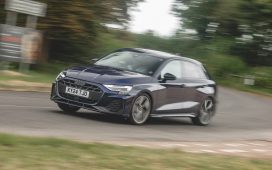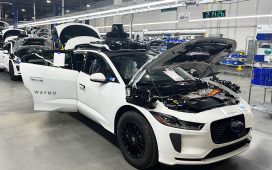We visited the Mazda Fan Festa at Fuji Speedway in Japan just over a month ago. The Mazda Fan Festa is a gathering of Mazda fans and owners organized by Mazda Motor Corporation itself. This event is perhaps the holy grail for all Mazda fans in Japan and even worldwide – an event worth the traffic jam of Mazdas to Fuji Speedway. Seeing a fleet of MX-5s, CX-60s, rotary-powered Cosmos, and RX-7s heading to the track was a hair-raising moment.
So, imagine the feeling we experienced once we were at the venue, seeing a racetrack we’d typically only encounter in video games like Gran Turismo. It was like meeting the Avengers for the first time.
Unlike the Avengers, these cars weren’t fictional. They might be the cars you’ve mainly driven in video games, but everything at this moment was real, just like the people behind the past and present of Mazda Motor Corp. The event began with a run of Mazda’s historical racecars, culminating in a run of the first Japanese racecar to win the 24 hours of Le Mans – the #55 787B. I’d argue that this is a car that should be on any enthusiast’s bucket list to see or even hear in person because it’s an iconic racecar that’s worth celebrating.
The Mazda 787B hurtled down the main straight of Fuji Speedway with its four-rotor rotary engine singing a high-pitched song that’s instantly recognizable. Stay close enough to it at full throttle, and it might probably rupture your eardrums. It’s really that loud. After the demonstration lap, all four generations of the Mazda MX-5, from the NA to the current ND2, joined the formation at the straight of Fuji Speedway where the brand’s top executive alighted.
The 787B was piloted by Yojiro Terada, who has participated in the 24 Hour of Le Mans multiple times, while stepping out of the ND2 is Mazda’s current CEO, Masahiro Moro. Moro-san and his team were the welcoming committee for this momentous occasion. The key message for the entire event has been Mazda’s unwavering quest to continue making cars that, at their core, are meant to deliver an emotionally rich driving experience.
That pursuit of carbon neutrality is evident in the ND2 MX-5 he was driving. That’s because it’s an MX-5 that uses a modified version of a 2.0-liter Skyactiv-G gasoline engine that accepts carbon-neutral fuels. These are joined by a Mazda 2 and Mazda 3 that are fed by biodiesel. Together with the aforementioned MX-5 and a duo of Toyota GR 86s and Subaru BRZs, these cars compete in the Super Taikyu endurance race series and also acknowledge Toyota’s multi-solution path to climate change.
Apart from these carbon-neutrality racecars, Mazda’s heritage collection is also on full display at the paddock. This showcased the brand’s most iconic cars throughout history, from the R360, which is their first production car, all the way to rotary-powered icons like the Cosmo, the RX-7, and the RX-8. The collection wouldn’t be complete without their present-day models like the Mazda 3, CX-5, and a reincarnation of the rotary engine in range-extender form with the MX-30 R-EV.
The Mazda MX-30 R-EV is a plug-in hybrid version of the MX-30. However, instead of being purely electric as we saw when it was launched at the 2019 Tokyo Motor Show, the MX-30 R-EV uses a rotary engine to extend the car’s admittedly not-so-impressive pure electric range. The rotary engine is not connected to the wheels; instead, it simply charges the 17.8 kilowatt-hour lithium-ion battery that, on its own, is good for 107 kilometers (kms) of pure electric driving. With the rotary engine charging the battery, the MX-30 R-EV can travel up to 640 kms with its 50-liter fuel tank.
Rotary engine still alive
Together with the aforementioned vehicles powered by carbon-neutral fuels, the Mazda Fan Festa also showcases that the rotary engine isn’t dead yet. The MX-30 R-EV is part of Mazda’s multi-solution approach, wherein it isn’t just relying on battery electric vehicles (EVs) to achieve carbon neutrality. While the rotary engine faced challenges regarding emissions that led to its discontinuation in 2012, Mazda is still committed to keeping the rotary engine alive in 2023 in whatever environmentally optimal form it’s deemed.
But is the rotary engine relegated to a behind-the-scenes role in 2023, with no longer being the main act in a vehicle? Well, we don’t know Mazda’s exact plans for this engine, but one thing we do know about Mazda is that they are determined to keep their cars emotionally rich, even in an era of electrification and carbon neutrality. And we appreciate them for that.
In the world’s pursuit of electrification, it’s challenging for an automaker to stand out. Like every automaker, Mazda has accelerated its commitment to becoming carbon neutral by 2035, and by 2030, they will be releasing a host of EVs. In the midterm, the company’s current strategy focuses on a multi-solution approach that will see improvements in the internal combustion engine (ICE), as evident with the CX-60 and CX-90, whose unique inline-6 gasoline engines are challenging the status quo in the segment. Simultaneously, despite bucking the industry trend of engine downsizing, Mazda’s strategy with their ICEs has led to improved real-world environmental performance, thanks to mild-hybrid electrification and “right-sizing,” which means fitting the appropriately-sized engine for the type of vehicle.
However, eventually, Mazda will have to bid farewell to the ICE as well. Without the noise of an ICE or the distinctive power delivery provided by various types of ICEs such as the rotary engine, EV drivetrains will make cars feel increasingly similar. The Mazda Fan Festa at Fuji Speedway is not just an event that celebrates the present but also connects the future while remembering what Mazda is all about.
Even in the EV age, we can be sure that these cars won’t simply be vehicles whose mechanical noises have been silenced by electric motors. Through Mazda’s multi-solution approach to achieving carbon neutrality, there will be an emotionally rich Mazda that comes in different forms and offers unique driving experiences.









